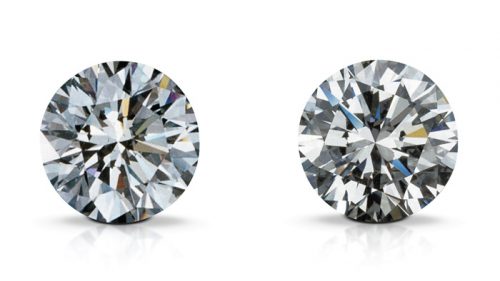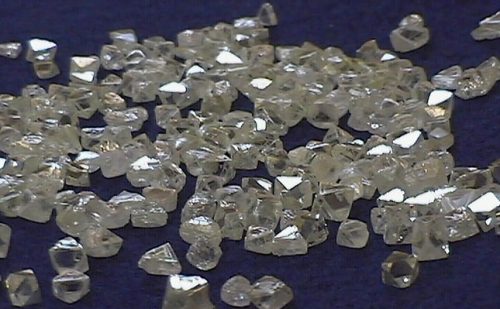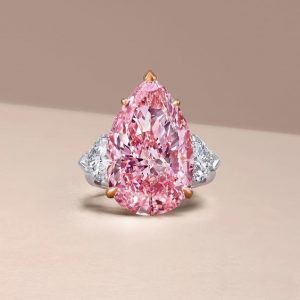In what can only be described as a victory for laboratory-grown diamond producers, the US Federal Trade Commission (FTC) has dropped the word ‘natural’ from its definition of a diamond, essentially redefining ‘diamond’ to include non-mined gemstones, as part its new guides for the jewelry industry. It further gives additional leeway to existing standards regarding the description of lab-grown diamonds (and metal alloys), and has dropped ‘synthetic’ as an appropriate descriptor of lab-grown diamonds except under certain circumstances. “The revision makes relatively far-reaching changes in what’s allowed as far as marketing lab-grown diamonds,” writes JCK’s Rob Bates, “and these changes almost entirely tilt toward the lab-grown sector.”
According to section § 23.12 of the Guides for the Jewelry, Precious Metals, and Pewter Industries, “Definition and misuse of the word ‘’diamond’,” the FTC writes: “A diamond is a mineral consisting essentially of pure carbon crystallized in the isometric system”, whereas it previously read “natural mineral”. “The Commision,” reads the Guide, “no longer defines a “diamond” by using the term “natural” because it is no longer accurate to define diamonds as “natural” when it is now possible to create products that have essentially the same optical, physical, and chemical properties as mined diamonds.” Later in the explanation of its changes, the commission describes why it sided with Diamond Foundry: “Diamond Foundry asked that the Commission remove “natural” from the diamond definition. It contended, “[t]he fact that diamonds exist in the soil of Earth” is “not a necessary attribute.” In its analysis, “The Commission agrees. The final Guides therefore eliminate the word “natural” from the diamond definition. When the Commission first used this definition in 1956, there was only one type of diamond product on the market – natural stones mined from the earth. Since then, technological advances have made it possible to create diamonds in a laboratory. These stones have essentially the same optical, physical, and chemical properties as mined diamonds. Thus, they are diamonds.”
‘Synthetic’ no longer recommended
In addition to this fundamental change to the definition of ‘diamond’, the FTC has opened the door to a much wider range of discriptors for lab-grown diamonds, provided they are not confusing for consumers. The Guides details its consideration of “cultured diamonds” according to the issues presented by the International Grown Diamond Association (IDMA) and Diamond Foundry on the one hand, and the Diamond Producers Association and Jewelers Vigilance Committee on the other. While the former did not get all it asked for (such as restricting the use of “ethical” or “conflict-free” diamonds to those from countries adhering to US labor standards), they tilted the balance in their favor. As Rob Bates points out, “In the past, the Guides listed the following approved descriptors for non-mined diamonds: laboratory-created, laboratory-grown, [manufacturer-name]-created, and synthetic. The new Guides still recommend the first three descriptions – though they no longer include synthetic. They also say that manufacturers can use other phrases if those terms “clearly and conspicuously convey that the product is not a mined stone.” And while adjectives such as created, grown and foundry are not recommended as descriptors, the commission says if the “suggested terms could be used non-deceptively in context (e.g., as part of an ad highlighting that the product is man-made), there is nothing to prevent marketers from doing so.”
As for using the word “cultured” to describe non-mined stones, the commission said it should be qualified, as the term on its own often leads consumers to believe a diamond is mined. The commission suggests marketers use words such as “man-made,” “lab-grown” or “foundry” to qualify “cultured,” thereby avoiding confusion about a diamond’s origins. However, marketers should not use the word “synthetic” to qualify “cultured,” the FTC noted, as it creates confusion among consumers, who believe the term indicates a stone is fake or artificial. Yet the commission goes even a step further in loosening its guidance on the use of ‘cultured’: While it still recommends against using the term cultured on its own, it now says that cultured can be used even if not immediately preceded by one of the approved descriptors.
Several commenters cited in the report, however, stated that the commission’s proposed guidance is inconsistent with international standards, which ban even the qualified use of “cultured” to describe synthetic diamonds. For example, a standard adopted by the International Organization for Standardization (ISO) in 2015 prohibits using “cultured” and “cultivated” to describe synthetic diamonds, and requires sellers to describe such products as “synthetic,” “laboratory-grown,” or “laboratory-created.” The JVC contended that the purpose of the ISO standard is “fully aligned” with the FTC Jewelry Guides. The fact that the FTC decided otherwise points to a rift between the new American standards and international ISO standards (a not uncommon rift nowadays). While the FTC removed ‘synthetic’ from its suggested descriptors, it declined to prohibit its use (another request by diamond growers), arguing that the term is not deceptive in every instance. But it did rule that it is misleading to use the term synthetic to “suggest a competitor’s lab-grown diamond is not an actual diamond.”
The changes, approved unanimously by the five-member commission, cap a six-year process of revamping the much-talked-about standards for marketing jewelry and gems. This revision marks the Guides’ first major overhaul in 22 years.
Source: thediamondloupe.
WFDB RESPONDS TO REVISED FEDERAL TRADE COMMISSION GUIDELINES |
|
The World Federation of Diamond Bourses (WFDB) has responded to the revised U.S. Federal Trade Commission’s (FTC) guidelines released last week as they relate to the issue of descriptors for diamonds. The new guidelines are not in line with the Diamond Terminology Guidelines as agreed last year and implemented by the WFDB, the International Diamond Council, the International Diamond Manufacturers Association and CIBJO, the World Jewellery Confederation, said WFDB President Ernie Blom. However, he pointed out that the new guides do require that all lab-grown diamonds must be clearly and conspicuously disclosed. “We have a united stand regarding nomenclature which was agreed with all the combined knowledge and experience of the leading industry bodies, but the FTC appears to have moved in a different direction,” Blom said. Previously, the FTC’s guidelines approved non-mined diamonds: laboratory-created, laboratory-grown, [manufacturer-name]-created, and synthetic as descriptors, and while the first three remain, it has removed the term synthetic. “We feel that these changes provide too much of a bias towards the lab-grown diamond sector,” said Blom. “We appreciate the hard work of the FTC, but we do not feel that the views of the diamond sector were taken sufficiently into account, though we acknowledge there was consultation with American industry bodies. The guidelines do not include the views of the global diamond trade which the WFDB represents, although we are pleased that lab-grown stones have to be clearly marked as such. “Our paramount aim is always consumer confidence and the revision has the potential to cause a degree of confusion. The FTC notes that manufacturers that make diamonds in a factory setting are free to use other descriptors as long as they ‘clearly and conspicuously convey that the product is not a mined stone,’ but we feel that this might provide too much latitude in their marketing claims. “We appreciate that the FTC rejected a bid by diamond growers to include terms such as [manufacturer-name]-grown, foundry, created, and grown. These are stones created to order in a factory. We are also pleased that the FTC makes clear that any descriptors for non-mined diamonds must be absolutely clear and prominently displayed to consumers. A diamond sold without any descriptors must be a natural diamond. “We hope that the door is still open for us to go back and approach the FTC in order to try and persuade the organization to re-think its decision,” Blom added. |


